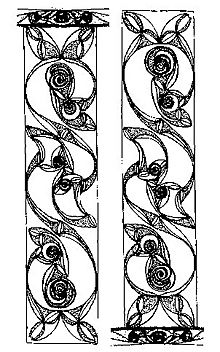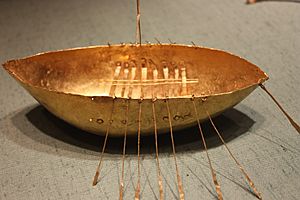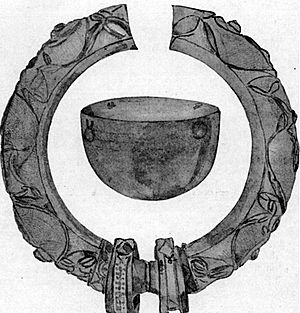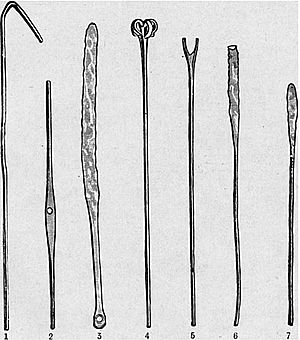Broighter Gold facts for kids
Quick facts for kids Broighter Hoard |
|
|---|---|

The boat, bowl, and part of the torc
|
|
| Material | Gold |
| Period/culture | 1st century |
| Discovered | 1896, near Limavady, Northern Ireland, by Tom Nicholl and James Morrow |
| Present location | National Museum of Ireland |


The Broighter Hoard is a famous collection of ancient gold objects. These amazing items date back to the Iron Age, around the 1st century BC. They were found in 1896 by two farmers, Tom Nicholl and James Morrow. They discovered the hoard on farmland near Limavady in what is now Northern Ireland.
The hoard includes a small gold boat, about 7 inches (18 cm) long. It also has a gold torc (a type of neck collar) and a gold bowl. There are also some other pieces of gold jewellery. Designs from the Broighter Hoard have been used on coins and stamps. For example, the gold ship appeared on a special Irish one-pound coin. Today, the hoard is kept safe at the National Museum of Ireland. Experts there say the torc is the "finest example of Irish La Tène goldworking." You can see copies of the collection at the Ulster Museum in Belfast.
Contents
How Was the Broighter Hoard Found?
The Broighter Hoard was found near Lough Foyle. This was in a field in a place called Broighter, close to Limavady. In February 1896, Thomas Nicholl and James Morrow were ploughing the field. They were using a method called "double ploughing." This means one plough followed another to dig deeper into the soil.
They found the gold objects about 14 inches (36 cm) deep. All the items were buried close together. The farmers took their discovery back to the farm. Maggie, who later married Tom Nicholl, washed the items in a sink. At first, they did not know the objects were made of gold.
Selling the Hoard
The hoard was eventually sold to the British Museum for £600. When it was first shown, it was described as a "lump of mud." The plough had badly damaged the boat. Later, a goldsmith had to work hard to figure out its original shape. A few days after the main discovery, a small part of the boat was found. Morrow's sister sold this piece to a jeweller in Derry.
What Was in the Broighter Hoard?
All the gold in the hoard is very similar in its metal makeup. However, the styles of the pieces are quite different. Some items might have been brought in from other places. Others might have been reshaped or made completely new.
The Amazing Gold Boat
The gold boat is a very special find. It measures about 7.25 inches (18.4 cm) long and 3 inches (7.6 cm) wide. It weighs about 3 ounces (85 grams). The boat has benches, places for oars, and two rows of nine oars. It even has a paddle rudder for steering.
The boat also came with tiny tools. These included grappling tools, forks, a mast, and a spear. These tools are much lighter than the boat's main body. Many people believe the boat was a votive offering. This means it was left as a gift to a god, possibly the Celtic sea god Manannán mac Lir.
The Beautiful Gold Torc
The torc is another amazing item. It is a large, hollow gold collar, about 7.5 inches (19 cm) across. It has special ends that fit together with a mortice and tenon fastening. The hollow tube of the torc is about 1.125 inches (2.8 cm) wide.
The torc's design is very detailed. Some parts show classic plant designs made by pushing back the gold around them. Other areas have extra pieces attached. The background has curved lines to add to the decoration. There are no other hollow torcs like this from Ireland. However, similar ones, like the Snettisham Torc, have been found in Britain. The gold for the torc might have come from the Rhineland area of Europe.
The Mysterious Gold Bowl
An unusual gold bowl was also found. It was made from a single sheet of gold. Its exact use is not clear. It was probably a model of a large cauldron. Cauldrons were important for feasts in Iron Age Europe. The bowl has four loops on the outside for hanging, but not all of them are still there. It is about 3.5 inches (8.9 cm) wide and 2 inches (5.1 cm) deep. It weighs over 1 ounce (28 grams).
Gold Chain Necklaces
The hoard includes two gold chain necklaces. They were made using a "loop-in-loop" technique. One necklace is 39.6 cm long and has three chains. The other has a single chain but is more complex. This chain-making style came from the Middle East to the Roman world. The clasps on these necklaces look like Roman and Etruscan examples. This suggests they were probably made in the Roman world.
Twisted Gold Bar Torcs
There are also two torcs made from single twisted bars of gold. This style is more common in Britain. One is complete, about 18.6 cm across. The other is a broken piece. These torcs likely came from what is now south-eastern England.
Who Owns the Broighter Hoard?
The farmer, J.L. Gibson, first sold the hoard to a jeweller in Derry. The jeweller then sold it to a local expert in old objects, Robert Day. Day later sold it to the British Museum for £600. The museum owned it without problems for a while.
However, in 1897, a famous archaeologist named Arthur Evans wrote about the find. The Royal Irish Academy then argued that the British Museum should not own it. They believed the hoard was "treasure trove." This means it was buried with the intention of being found again. The Academy wanted the items to be declared treasure and given to Ireland. Robert Day was so upset by this argument that he decided not to give a gift he had planned for the Irish Academy.
The Court Case
The British Museum argued that the hoard was a "votive offering." This means it was a gift left for ancient gods, not buried to be found again. They pointed to the boat model and a "sea-horse image" on the torc. They also noted that shells were found nearby. This suggested the treasure was placed in water as an offering. The map of the find spot shows how close it was to the sea and to land that used to be part of the water.
The argument went to court in London in 1903. A key point in the case was that the items were packed closely together. This suggested they were buried on purpose. The court decided that the treasure was not a religious offering. Therefore, it belonged to the Crown (the government). The treasure was then taken to Dublin and placed in the museum there.
Even today, some people think the gold should be moved closer to where it was found in Northern Ireland. However, the items remain in the National Museum of Ireland in Dublin.
Why Is the Broighter Hoard Important?
The Broighter Hoard is a very important archaeological find. The National Museum of Ireland says the collar is the "finest example of Irish La Tène goldworking" in all of Europe. The mix of different styles in the hoard is similar to objects found in the Stirling Hoard from Scotland.
The torc was used in a design for a British pound coin in 1996. The boat was also used for the design of the very last pound coin issued by the Irish Mint. This coin came out in 2000 to celebrate the new millennium.
Images for kids








